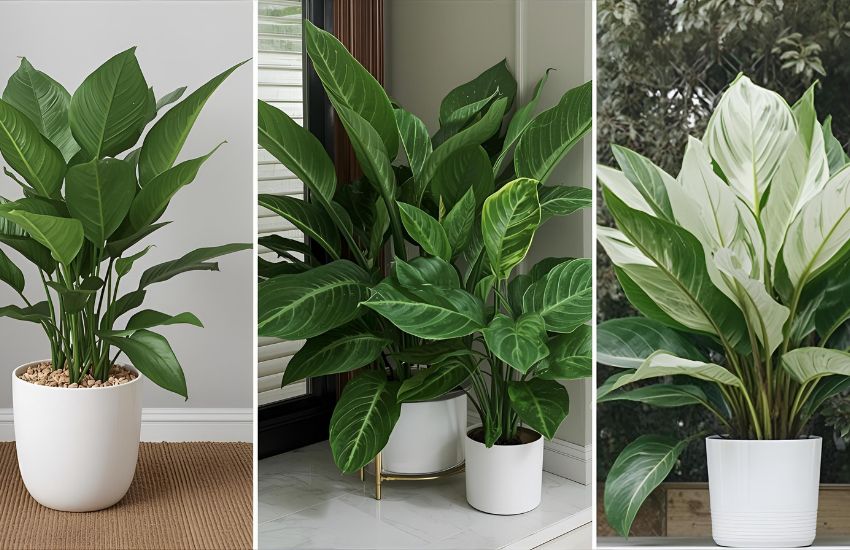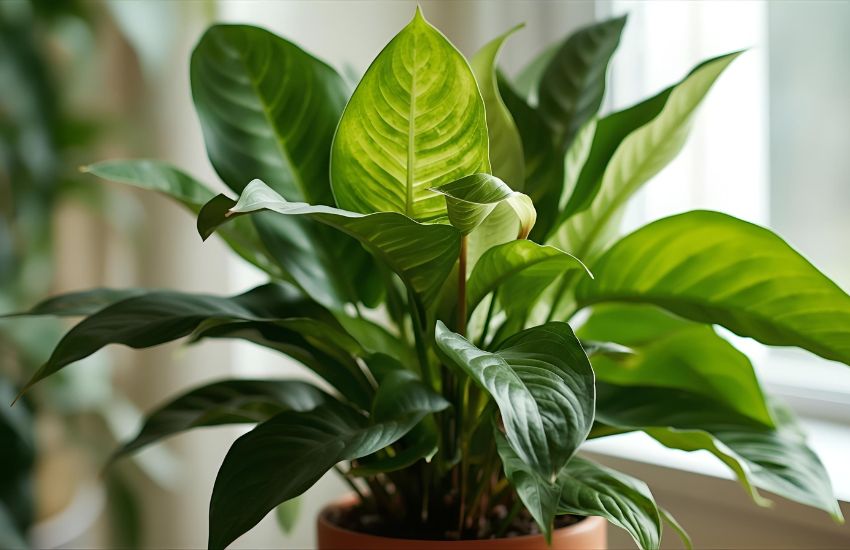If you want to grow a striking, low-maintenance houseplant indoors, the Dieffenbachia, commonly known as the dumb cane plant, is a perfect choice. With its lush, variegated leaves and elegant presence, this tropical beauty adds life and sophistication to any indoor space. However, to truly thrive, dieffenbachias require specific care routines that go beyond simply watering. You must understand how they respond to indirect light, maintain optimal humidity, and provide balanced fertilizer during the growing season.
Dieffenbachia, or Dumb Cane, thrives indoors with bright, indirect light and consistently moist, well-draining soil. Keep your plant away from pets, as it’s toxic if ingested. Water every 1–2 weeks, allowing the topsoil to dry slightly between watering. Fertilize monthly during spring and summer, and wipe leaves regularly to remove dust for healthy growth.
In this comprehensive Dieffenbachia Plant Care Guide, you will discover step-by-step strategies to care for dieffenbachia, tips for planting dieffenbachia in pots, and practical advice to keep your tropic snow or other dieffenbachias thriving indoors, ensuring your dumb cane remains vibrant and healthy year-round.
Popular Types of Dieffenbachia to Grow as Stunning Houseplants

Dieffenbachia plants are celebrated for their dramatic foliage and easy adaptability as indoor plants. When choosing a dumb cane plant for your home, understanding the different dieffenbachia spp can help you pick one that matches your space and care routine.
Tropic Snow
The Tropic Snow variety showcases large, creamy leaves with green edges, making it a standout in any room. It thrives in moist soil, but be careful not to overwater. Allow the top inch of the soil to dry before watering again to prevent root rot. Use houseplant fertilizer during the growing season to encourage new growth.
Leopard Lily
Also known as the Leopard Lily, this dieffenbachia can grow up to 6 feet tall indoors, creating a bold statement. It tolerates lower light but still prefers bright, indirect light. Watch for yellow leaves, a sign of either overwatering or nutrient deficiency, and water your dieffenbachia accordingly.
Caring Tips for All Varieties
When handling your dumb cane, always wear gloves to avoid contact with the sap, which contains calcium oxalate and can irritate children and pets. Protect your plant from cold drafts and remove lower leaves that turn yellow. Replace fresh soil when repotting and monitor for common pests like spider mites. Avoid letting the top inch stay too wet, as overwatered soil can cause serious damage. Dilute your houseplant fertilizer for gentle feeding to keep your dieffenbachia healthy.
With proper care, these varieties will thrive indoors, adding elegance and lush greenery to your space while remaining safe and manageable.
How to Prune Dieffenbachia Plant and Fix Common Problems or Pests

Proper pruning is essential to keep your dumb cane plant healthy, encourage new growth, and address common issues caused by pests or improper care.
Pruning Damaged Leaves
You should regularly remove damaged leaves or yellowing foliage to maintain your plant’s appearance and health. Use clean scissors or pruning shears, and always wear gloves, as the plant’s toxic sap contains calcium oxalate crystals that can irritate skin. Avoid letting the sap comes into contact with your eyes or mouth, and keep pruned material away from children and pets.
Taking Stem Cuttings
If you want to propagate your dieffenbachia, take stem cuttings from healthy sections of the plant. Allow the cuttings to callous slightly before planting in fresh, moist soil. Your plant thrives when it receives bright indirect light and average household humidity, so choose a spot that the plant likes.
Addressing Pests and Diseases
Common pests, such as aphid, can be controlled by wiping leaves with insecticidal soap or neem oil. Inspect your large leaves regularly for signs of infestation. Ensure the soil isn’t constantly wet, as overwatering can lead to diseases like root rot. Only water your plant when the soil is dry or the top inch feels dry, preventing damage caused by soggy roots.
Conclusion
Caring for your dieffenbachia doesn’t have to be complicated. By understanding what plant needs, providing well-draining potting mix, and ensuring the soil is checked every four to six weeks, you can keep your plant healthy and thriving. These resilient plants can tolerate lower light and adapt well to lower light conditions, but they flourish when placed to thrive in bright indirect light while you avoid direct sunlight.
Choosing the right spot, using easy to propagate stem cuttings, and keeping the plant away from pets ensures both safety and longevity. Remember to fertilize weeks during the growing season and choose a pot that supports growth.
For plant lovers eager to elevate their indoor greenery, following these tips will make your dumb cane plant a stunning centerpiece in any room. Take action today—apply these strategies, and watch your dieffenbachia flourish beautifully indoors!
Frequently Asked Questions (Dieffenbachia Plant Care Guide for Thriving Dumb Cane Houseplant Indoors)
How to grow a healthy Dieffenbachia Dumb Cane plant indoors?
To grow a healthy Dieffenbachia Dumb Cane plant indoors, place it in bright, indirect light and keep the soil consistently moist but not soggy. Maintain warm temperatures and high humidity. Avoid cold drafts and direct sunlight. Feed monthly with a balanced liquid fertilizer during the growing season and wipe leaves to keep them dust-free.
How to make a Dieffenbachia bushy?
To make a Dieffenbachia bushy, prune the top stems just above a leaf node to encourage side shoots. Place the plant in bright, indirect light and rotate it regularly for even growth. Keep the soil evenly moist but not soggy, and feed monthly during spring and summer with a balanced, diluted liquid fertilizer.
Why are the tips of my Dieffenbachia leaves turning brown?
The tips of your Dieffenbachia leaves turn brown mainly due to low humidity, underwatering, or buildup of salts from fertilizer. Dry indoor air and inconsistent watering stress the plant, while excess fertilizer burns the leaf edges. Maintain moderate humidity, water regularly with filtered water, and flush the soil occasionally to prevent salt accumulation.
Do Dieffenbachia like big pots?
Dieffenbachia plants do not like being in pots that are too big. Oversized pots retain excess moisture, which can cause root rot. Choose a pot only 1–2 inches larger than the current one to allow gradual growth and proper drainage. A snug pot helps maintain healthy roots and prevents overwatering issues.
